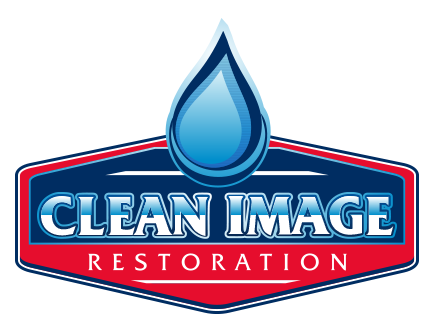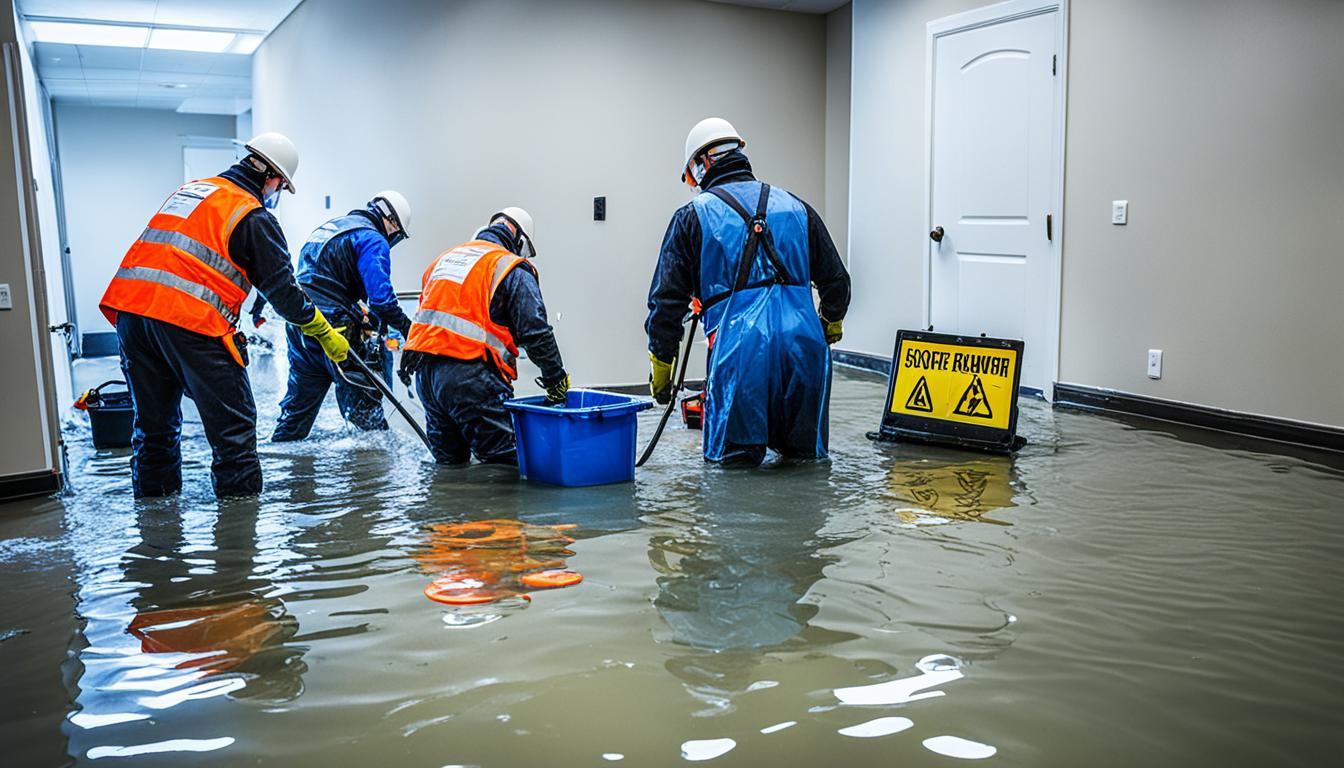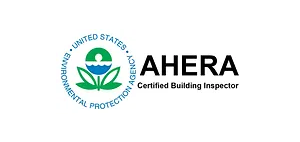Dealing with water damage can be a stressful and overwhelming experience. Whether it’s caused by a burst pipe, heavy rainfall, or a faulty appliance, the consequences can be devastating. To ensure the successful restoration of your property, it’s important to know what mistakes to avoid. In this section, we will discuss common errors that can hinder the water damage restoration process and compromise the safety and integrity of your home or business.
Key Takeaways:
- Acting promptly is crucial when addressing water damage.
- Ignoring safety precautions during cleanup can lead to accidents and injuries.
- Proper drying and dehumidification are essential to prevent further damage and mold growth.
- Don’t underestimate the importance of professional assistance for thorough restoration.
- Regular maintenance and inspections can help prevent future water damage incidents.
Acting too slowly in addressing water damage
When it comes to water damage, time is of the essence. Acting promptly is crucial to minimize the potential risks and costs associated with water damage restoration. Delaying the addressing of water damage can lead to further structural damage, mold growth, and expensive repairs.
The longer you wait to address water damage, the more extensive the damage can become. Water can seep into walls, floors, and other porous materials, causing them to weaken and deteriorate over time. This can result in structural instability and costly repairs that could have been avoided by taking immediate action.
One of the key risks of acting slowly in addressing water damage is the growth of mold. Mold can start to develop in as little as 24 to 48 hours after water damage occurs. Mold not only damages the affected areas but also poses serious health risks to you and your family, especially those with respiratory issues or weakened immune systems.
To prevent further damage and mitigate the risks associated with water damage, it is essential to address the issue immediately. Here are some tips to help you address water damage promptly:
- Turn off the water source: If the water damage is caused by a burst pipe or leaking appliance, locate the main water valve and shut it off to prevent further water flow.
- Remove excess water: Use towels, mops, or a wet/dry vacuum to remove standing water as quickly as possible.
- Call a professional restoration company: Contact a reputable water damage restoration company to assess the extent of the damage and provide expert assistance in drying and restoring your property.
- Document the damage: Take photos or videos of the affected areas and damaged belongings as evidence for insurance claims.
- Ensure proper ventilation: Open windows and use fans or dehumidifiers to promote airflow and help dry out the affected areas.
By acting swiftly and following these steps, you can minimize the severity of water damage and protect your property from further harm. Don’t wait until it’s too late. Address water damage immediately to safeguard your home or business.
| Consequences of Delaying Water Damage Restoration | Risks of Acting Slowly |
|---|---|
| Deterioration of structural integrity | Mold growth and health hazards |
| Increased repair costs | Damage to personal belongings |
| Weakened foundation | Insect infestation |
Ignoring safety precautions during water damage cleanup
Safety should always be a top priority during water damage cleanup. Failing to take the necessary precautions can result in accidents and further damage to your property. To ensure a safe and effective cleanup process, avoid the following common safety mistakes:
1. Handling electrical appliances without caution
When dealing with water damage, it’s crucial to exercise extreme caution when handling electrical appliances or equipment. Water can cause electrical circuits to short out, presenting a serious risk of electric shock or even fire. Before attempting any cleanup, turn off the power to the affected area and unplug any electronics. If you’re unsure about the safety of electrical items, it’s best to consult a professional electrician.
2. Failing to wear proper personal protective equipment (PPE)
Water damage cleanup often involves exposure to contaminated water and potentially harmful substances. To protect yourself, always wear appropriate personal protective equipment (PPE) such as gloves, goggles, and a face mask. This will help minimize the risk of skin irritation, respiratory issues, and infections.
3. Not addressing mold growth promptly
Moisture from water damage can quickly lead to mold growth, which can pose serious health risks to you and your family. Ignoring or not properly addressing mold can exacerbate respiratory conditions and allergies. If you notice signs of mold, such as a musty odor or visible patches, it’s essential to take immediate action by contacting a professional mold remediation company.
4. Neglecting proper ventilation
During water damage cleanup, it’s crucial to ensure proper ventilation to prevent the buildup of harmful fumes and airborne contaminants. Open windows and use fans or dehumidifiers to promote airflow and aid in drying out the affected area. Avoid using gasoline-powered generators or other devices that produce carbon monoxide indoors.
5. Attempting extensive cleanup without professional assistance
While minor water damage cleanup can often be done by homeowners, extensive or severe damage may require professional assistance. Professionals have the knowledge, equipment, and experience to handle large-scale cleanup and restoration safely and effectively. Don’t hesitate to contact a water damage restoration company if you’re unsure about the extent of the damage or if you’re dealing with contaminated water sources.
By avoiding these safety mistakes and taking the necessary precautions, you can ensure a safe and successful water damage cleanup process, protecting both your property and your well-being.
Neglecting proper drying and dehumidification
When it comes to water damage restoration, neglecting proper drying and dehumidification can have serious consequences. The aftermath of water damage often includes pockets of moisture that can seep into building materials, leading to further damage and facilitating mold growth. It is crucial to understand the importance of thorough drying techniques and the role of dehumidification in preventing long-term issues.
Proper drying involves the systematic removal of moisture from affected areas, ensuring that no lingering dampness remains. This requires utilizing professional-grade drying equipment, such as air movers and dehumidifiers, to extract moisture efficiently. Without adequate drying, residual moisture can compromise the structural integrity of a property, leading to rot, warping, and even potential collapse.
Dehumidification is another critical element of the drying process that should not be overlooked. Dehumidifiers help reduce humidity levels in moisture-laden areas, preventing the growth of mold and bacteria. By maintaining optimal humidity levels, you can safeguard your property and maintain a healthy indoor environment.
One common mistake in water damage restoration is assuming that visible drying on the surface means the job is done. However, moisture can hide within walls, flooring, and other porous materials, causing hidden damage and promoting microbial growth. Neglecting proper drying can result in recurring water damage issues, compromising the structural integrity of your property and posing health risks to occupants due to mold contamination.
To ensure thorough drying, it is essential to work with professional water damage restoration experts who have the expertise, equipment, and knowledge to assess the extent of the damage and implement effective drying strategies.
By addressing proper drying and dehumidification in your water damage restoration process, you can mitigate the risk of further damage, protect your property, and restore a safe and healthy living environment.
| Dangers of Neglecting Proper Drying and Dehumidification | Benefits of Thorough Drying and Dehumidification |
|---|---|
| 1. Structural damage, including rot and warping | 1. Prevention of further damage and restoration costs |
| 2. Mold growth and bacterial contamination | 2. Reduction of health risks associated with mold |
| 3. Hidden moisture leading to recurring water damage | 3. Improved indoor air quality and occupant well-being |
Conclusion
In conclusion, when it comes to water damage restoration, it is crucial to avoid making common mistakes that can lead to further damage and unnecessary expenses. By following the guidelines presented in this article, you can ensure a successful restoration process and safeguard your property.
Acting promptly is key when addressing water damage. Delays in restoration efforts can result in structural damage, mold growth, and potential health hazards. Remember to immediately assess the situation, contact professionals, and start the cleanup process to minimize the risks associated with water damage.
Additionally, ignoring safety precautions during water damage cleanup can have serious consequences. It is essential to prioritize safety by wearing protective gear, handling electrical appliances with caution, and properly disposing of contaminated materials. By taking these precautionary measures, you can protect yourself and your loved ones from potential accidents and health risks.
Lastly, neglecting proper drying and dehumidification can prolong the recovery process and create favorable conditions for mold growth. Ensure that all affected areas are thoroughly dried to prevent further damage and reduce the chances of mold infestation. By doing so, you can save time, money, and the integrity of your property.
FAQ
What are some mistakes to avoid when dealing with water damage restoration?
Avoiding these mistakes can help ensure the safety and integrity of your property during the restoration process.
Why is it important to address water damage promptly?
Acting too slowly in addressing water damage can lead to more extensive damage, mold growth, and potential health hazards. It’s crucial to take immediate action.
What safety precautions should I take during water damage cleanup?
During water damage cleanup, it’s essential to handle electrical appliances with caution, wear protective gear, and ensure the proper disposal of contaminated water.
Why is proper drying and dehumidification important in water damage restoration?
Properly drying and dehumidifying moisture-laden areas is crucial to prevent further damage, mold growth, and the potential for structural issues. Neglecting this step can result in long-term consequences.






